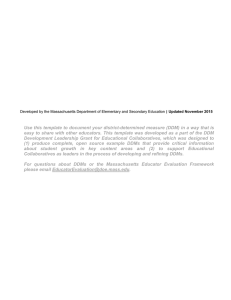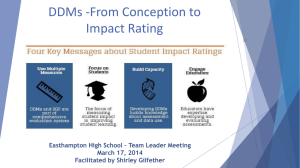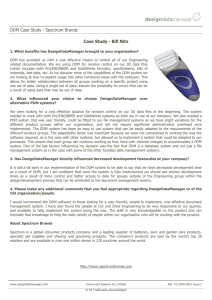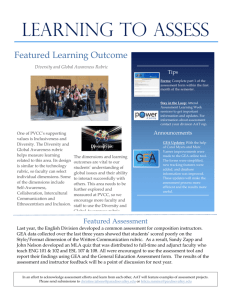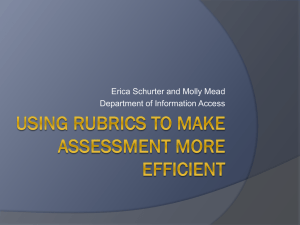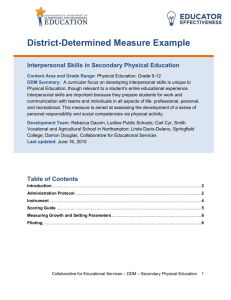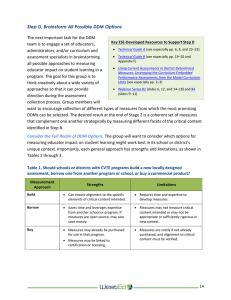Development Report Social Emotional Learning in HS - Ages 14-22
advertisement
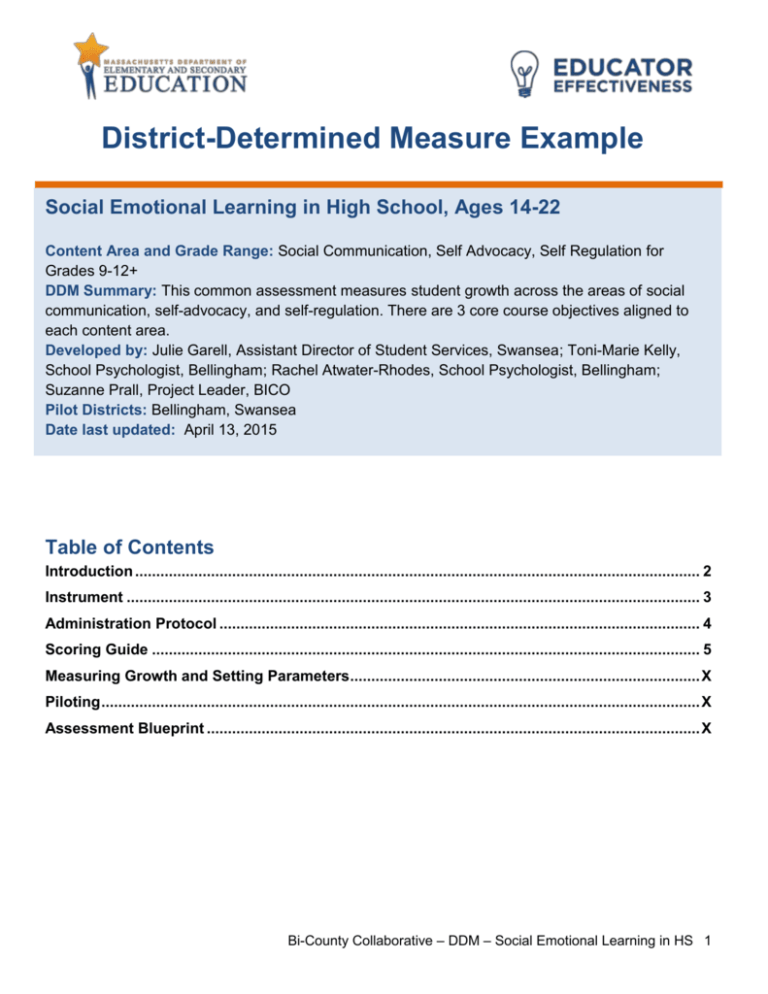
District-Determined Measure Example Social Emotional Learning in High School, Ages 14-22 Content Area and Grade Range: Social Communication, Self Advocacy, Self Regulation for Grades 9-12+ DDM Summary: This common assessment measures student growth across the areas of social communication, self-advocacy, and self-regulation. There are 3 core course objectives aligned to each content area. Developed by: Julie Garell, Assistant Director of Student Services, Swansea; Toni-Marie Kelly, School Psychologist, Bellingham; Rachel Atwater-Rhodes, School Psychologist, Bellingham; Suzanne Prall, Project Leader, BICO Pilot Districts: Bellingham, Swansea Date last updated: April 13, 2015 Table of Contents Introduction ...................................................................................................................................... 2 Instrument ........................................................................................................................................ 3 Administration Protocol .................................................................................................................. 4 Scoring Guide .................................................................................................................................. 5 Measuring Growth and Setting Parameters ................................................................................... X Piloting .............................................................................................................................................. X Assessment Blueprint ..................................................................................................................... X Bi-County Collaborative – DDM – Social Emotional Learning in HS 1 Introduction Working collaboratively, a group of related service providers from 10 school districts in MA developed this measure of student growth in the area of social emotional learning. The developers reviewed curriculum content used in their districts, along with the MA common core Speaking and Listening Standards Pre-K -12 and MA Mental Health Standards Pre-K -12. The result was an agreement on core course objectives for each area: social communication, self-regulation, and selfadvocacy. Different approaches to measuring student learning were reviewed and discussed, e.g., pre-post assessments, repeated measures, holistic approach, posttest only, portfolio, etc. Performance assessment scored on a rubric made the most sense to measure student growth in the area of social–emotional learning with demonstration and generalization in the classroom being the ultimate goal. The target audience for this common measure encompasses high school students aged 14-22 who have been identified as needing small group or individual intervention in the area of social/emotional skills, including students who have been identified with disabilities. The evaluator can modify the instrument in one, two, or three of the content areas covered by the instrument – social communication, self-regulation, and self-advocacy. This measure is intended to be used by Specialized Instructional Support Personnel, such as School Psychologists, counselors, Special Educators, etc., during counseling and/or social skills group interventions. Bi-County Collaborative – DDM – Social Emotional Learning in HS 2 Content (Standard) Social Communication: Perspective Taking – Student will be able to demonstrate an understanding of the thoughts and feelings of someone else. Understanding Norms – Student will be able to understand and demonstrate expected behavior. Social Pragmatics – Student will be able to engage in social interactions using expected verbal and nonverbal communication skills. Self-Advocacy: Identifying Needs – Students will be able to accurately self-assess their needs. Identifying Resources – Student will be able to identify and access the person(s) and/or appropriate resources or strategies to execute and/or implement their plan. Communicating Need – Student will be able to express need and evaluate options and take expected action/develop a plan to address the need. Self-Regulation: Self-awareness – Studentx will be able to identify internal feelings and emotions and their physiological responses. Self-Management – Student will evaluate and use expected coping strategies. Problem Solving – Student will develop an action plan in response to triggers or conflict. Weight 33% of the measure 33% of the measure 33% of the measure 100% Instrument The instrument consists of three rubrics, one for social communication, one for self-regulation, and one self-advocacy. Each rubric addresses 3 core course objectives with four levels of performance expectations ranging from low to high in cognitive complexity – remembering, understanding, applying, and analyzing/evaluating/creating. This DDM suggests performance activities and tasks for each level for each core course objective. Students will be asked by the evaluator to complete various performance tasks and activities, including orally responding to visuals, listening to Bi-County Collaborative – DDM – Social Emotional Learning in HS 3 stories/scenarios, and responding/ discussing, creating a drawing, and completing graphic organizers, as well as worksheets to demonstrate knowledge and skills related to each core course objective. Educators will first select which skills area(s) – social communication, self-advocacy or selfregulation – is consistent with the needs areas of the student(s) in the group to be assessed. The educator then selects the rubric for the identified skill area. The educator may use all or some of the subsections for the identified skill area, for example, if the student’s area of concern is social communication, the educator can use the rubric to evaluate perspective taking, social pragmatics and understanding norms, or choose only some of these areas, depending on the student’s identified need. The rubrics identify the tasks and activities provided for each core course objective and for each level of the rubrics. Administration Protocol When is the measure administered? A baseline measure will be given when initially beginning to work with a student. The measure will be administered at the end of each marking period to determine progress on each objective. The measure can be additionally administered as needed throughout the school year, e.g. before a progress meeting, when determining continued need for services, as recommended by Tea. How is the measure administered? This measure is developed as a rubric for specialized instructional support personnel, and does not include a time limit or time constraints. It is intended for use within counseling sessions. Students will be allowed as much time as needed when completing specific tasks and activities. Based on the rubric, the educator will use the scoring sheet for the identified course objective(s) to record the student’s score for each activity assessed. How will accommodations be documented? This measure serves as a rubric for completion by specialized instructional support personnel; the tool could therefore be modified to meet the support personnel’s needs. The specific tasks, questions, or activities can be modified in any way to accommodate the student whom the support personnel are trying to assess. For example, if a student is unable or unwilling to complete writing tasks, the educator can allow the students to verbalize their answers while the educator scribes. How are deviations to protocols addressed? This assessment can be given to any student, regardless of time of year, dependent on when the support personnel begin working with them. Bi-County Collaborative – DDM – Social Emotional Learning in HS 4 Scoring Guide Using the scoring guide and scoring sheet, the specialized instructional support personnel will meet with the student over a few counseling sessions and go through the prescribed tasks. The support personnel will score the student in each of the categories. The initial process will be deemed the pre-test and used as the baseline for data and measuring growth. Bi-County Collaborative – DDM – Social Emotional Learning in HS 5
